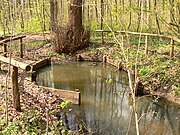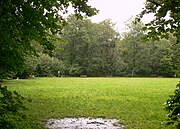Size comparison
In Germany, the Eilenriede is part of a group of inner-city and near-city forest areas, like the Rostock Heath (6,000 hectares or 15,000 acres), the Dresden Heath (5,900 hectares or 15,000 acres), the Frankfurter Stadtwald (4,800 hectares or 12,000 acres) and the Berliner Grunewald (3,000 hectares or 7,400 acres). The Eilenriede is around the same size as the Stadtwald in Duisburg (600 hectares or 1,500 acres) and is nearly twice as large as Central Park (340 hectares or 840 acres) in New York.
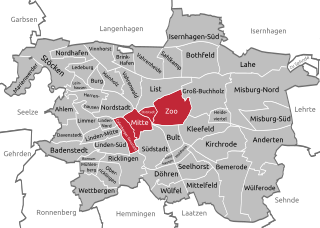
Mitte is the first borough of Hanover, the state capital of Lower Saxony. As of 2020, it has 36,645 inhabitants and consists of the quarters Mitte, Calenberger Neustadt, Oststadt and Zoo. The district mayor is Cornelia Kupsch (CDU).
The following is a timeline of the history of the city of Hanover, Germany.
Helmut Knocke is a German architecture historian and author.

Aegidien Church, after Saint Giles to whom the church was dedicated, is a war memorial in Hanover, the capital of Lower Saxony, Germany. The church dates from 1347, when it replaced an older Romanesque church dating to 1163. This in turn replaced an even earlier chapel. Aegidien Church was destroyed during the night beginning 8 October 1943 by aerial bombings of Hanover during World War II. In 1952, Aegidien Church became a war memorial dedicated to victims of war and of violence.

The aerial bombings of Hanover are a series of eighty-eight air raids by Royal Air Force (RAF) Bomber Command and the United States Army Air Forces (USAAF) on the German city of Hanover during World War II. Collectively these air raids killed 6,782 persons, predominantly civilian residents. Around 1,000 aerial mines, 34,000 high explosive bombs, 900,000 incendiary bombs and 50,000 fire bombs were dropped. The most destructive and deadly air raid on Hanover was conducted by the RAF on the night beginning 8 October 1943, killing 1,245 persons, and is an example of carpet bombing of suburban and residential civilian targets laid out in the Area Bombing Directive of 14 February 1942.
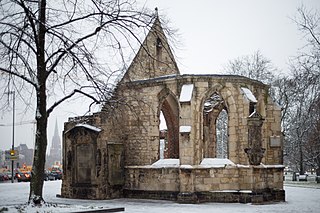
St. Nicholas' Chapel is an architectural heritage monument and the oldest building in Hanover, Germany. First built as a chapel dedicated to Saint Nicholas between 1250 and 1284 and a choir dating to 1325, it was damaged severely during the aerial bombings of Hanover during World War II. In 1953 the then approximately 700-year-old chapel was largely torn down to make way for a road as part of a larger post-war city-wide strategy to accommodate cars, with the currently 699-year-old choir left standing as a monument.
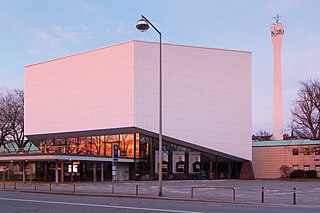
The State Radio House of Lower Saxony is a group of buildings owned by the public broadcaster Norddeutscher Rundfunk in Hanover, the state capital of Lower Saxony, Germany.

Johann Georg Christian Kestner was a German lawyer and archivist. He is also notable as the model for Lotte's husband Albert in The Sorrows of Young Werther by Goethe, with Kestner's fiancée Charlotte Buff used as the model for Lotte herself.

Hanover Drama is a theatre company in Hanover, the state capital of Lower Saxony, Germany. The company is resident at the Hanover Playhouse situated approximately 200 metres (660 ft) east of Hanover Opera House, and the Ballyard situated approximately 530 metres (1,740 ft) west-southwest of the opera house in the old town. Collectively these venues have five stages:

Jasper Hanebuth was a German mercenary in the Thirty Years' War, as well as a robber and murderer.
The hübschefamilies were the third elite class of the Electorate and Kingdom of Hanover in the 18th and early 19th centuries, after the nobility and the clergy. At the time Hanover was in a personal union with the United Kingdom. The group consisted of the higher bourgeoisie and the elite of university-educated civil servants, and played a significant role in the governing of Hanover, often as higher civil servants.
Heinrich Lutter was a German pianist and piano educator.

Hugo Thielen is a German freelance author and editor, who is focused on the history of Hanover, the capital of Lower Saxony, in a lexicon of the city, another one especially of its art and culture, and a third of biographies. He co-authored a book about Jewish personalities in Hanover's history.

Klaus Mlynek is a German historian and scientific archivist, a former director of the City of Hanover Archive, and one of the editors and authors of the Hannover City Lexicon, an encyclopedia of Hanover.
Waldemar R. Röhrbein was a German historian. He worked as a museum director in Lower Saxony, his last post being from 1976 to 1997 at the Historisches Museum Hannover, and was president of the Homeland Federation of Lower Sachsony. He contributed to encyclopedias about Hanover's history and culture.

Hanover Historical Museum is an historical museum situated in Hanover, the capital of Lower Saxony, Germany. The museum was founded in 1903 as the Homeland Museum of the City of Hanover. Its collections are related to the history of the city, the history of the House of Guelf, and of the state of Lower Saxony.
Dirk Böttcher was a German printer master, author and president of the association of Friends of the Historisches Museum Hannover.

Broyhan House is a residential and commercial building constructed in 1576 in Hanover's historic old town. It is the second-oldest preserved half-timbered building in Hanover, and stands on the cellar walls of an earlier building dating to the 14th century. The house is named after Cord Broyhan, a brewer who lived in an earlier building from 1537 until 1561.
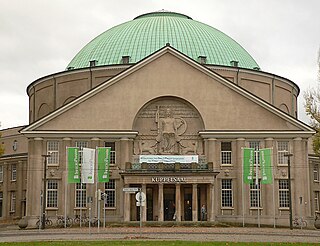
The Stadthalle Hannover is a concert hall and event venue in Hanover, the capital of Lower Saxony, Germany. The large hall is called Kuppelsaal, after its dome. The hall was opened in 1914. It is the largest hall for classical music in Germany, seating 3,600. Severely damaged during World War II, it was restored slightly altered. The hall is now part of the Hannover Congress Centrum. The listed historic building is a landmark of the city.
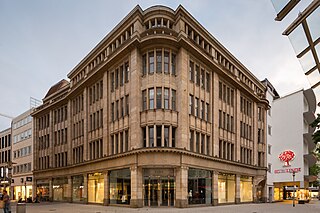
Elsbach & Frank was a textile retail business founded in the 19th century in Hanover, the capital of Lower Saxony, Germany. The department store built by the business on the corner of Osterstraße and Große Packhofstraße, called Zum Stern, is the only building in the city centre that survived the air raids on Hanover during the Second World War without major damage. Today, the building houses a branch of the Spanish fashion chain Zara.





